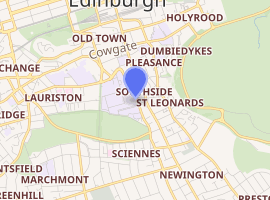Orthodox Chapel of St Andrew
The Orthodox Chapel of St Andrew, originally St. Cuthbert's Chapel of Ease, was built as a chapel of ease for the congregation of the St Cuthbert's Church, a Church of Scotland parish in Edinburgh. Opened in 1756, it is the oldest ecclesiastical edifice in the south side of Edinburgh. The building is sited at 33 Chapel Street, adjacent to the University of Edinburgh.[2] It was later renamed Buccleuch Parish Church and is now used by The Orthodox Community of Saint Andrew in Edinburgh.
| Orthodox Chapel of St Andrew | |
|---|---|
| Greek Orthodox Chapel of St Andrew | |

| |
| 55°56′37″N 3°11′07″W | |
| Location | Edinburgh, Scotland |
| Country | United Kingdom |
| Denomination | Greek Orthodox |
| History | |
| Former name(s) | St. Cuthbert's Chapel of Ease Buccleuch Parish Church |
| Status | Chapel |
| Founded | 1756 |
| Dedication | St. Cuthbert |
| Consecrated | January 1756 |
| Events | Sold to Greek Orthodox community |
| Architecture | |
| Functional status | Active |
| Construction cost | £640 (£95.9 thousand in 2020)[1] |
| Closed | 1969 (as Buccleuch Parish Church) |
| Clergy | |
| Priest in charge | The Very Revd. Archimandrite Raphael Pavouris |
| Priest(s) | The Very Revd. Archimandrite Hieromonk Avraamy Neyman The Revd Presbyter Luke Jeffery |
| Deacon(s) | The Revd. Antonios Kakalis |
History
Originally built to accommodate the growing congregation of St. Cuthbert's parish which was no longer able to accommodate the parishioners and was itself in need of urgent rebuilding. Subscriptions requested and by March 1755 this amounted to £460. Land at the Windmill at the west end of the Crosscauseway was then feued. The building cost £640 and 10 shillings to construct, and seated 1,200 worshippers.[3] The chapel was opened for public worship in January 1756. Seat rents were fixed yearly by the kirk session and those who had subscribed five guineas or upwards towards the erection of the chapel. Furthermore, the subscribers and twenty-one managers joined with the ministers and kirk session of St. Cuthbert's in arranging pulpit supply.
In June, 1763, the ground surrounding the chapel was opened for interments. The graveyard, which occupies the site of the windmill that pumped up water from the Borough Loch (Meadows) for the Society of Brewers, contains remains of several eminent people including Thomas Blacklock, the "discoverer" of Burns; Alexander Adam, a rector of the High School of Edinburgh and writer on Roman antiquities; Alison Cockburn, a Scottish poet; and Deacon Brodie, a Scottish cabinet-maker, deacon of a trades guild, and Edinburgh city councillor, who maintained a secret life as a housebreaker, partly for the thrill, and partly to fund his gambling, among others. The churchyard was in constant use till 1820, when it was closed to all but those who had purchased ground. At the same time there was opened a new place of sepulture in East Preston Street.
The building was remodelled and extended in 1866. The church closed in 1969, and having been used by the University of Edinburgh for storage for 40 years[4] was sold to The Orthodox Community of Saint Andrew in Edinburgh and reopened in 2015.[5]
References
- UK Retail Price Index inflation figures are based on data from Clark, Gregory (2017). "The Annual RPI and Average Earnings for Britain, 1209 to Present (New Series)". MeasuringWorth. Retrieved 2 February 2020.
- "Site Record for Edinburgh, 33 Chapel Street, Buccleuch Parish Church Buccleuch Street And Chapel Street, Buccleuch Parish Church Prints". Royal Commission on the Ancient and Historical Monuments of Scotland. 2011. Retrieved 17 July 2011.
- "St Cuthbert's Website : The Kirk – 18th Century History". Retrieved 17 July 2011.
- Historic Environment Scotland. "CHAPEL STREET, FORMER BUCCLEUCH PARISH CHURCH (Category C) (LB26785)". Retrieved 18 March 2019.
- City of Edinburgh Council: Planning records 2013